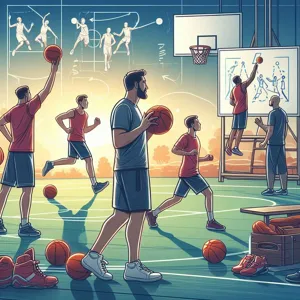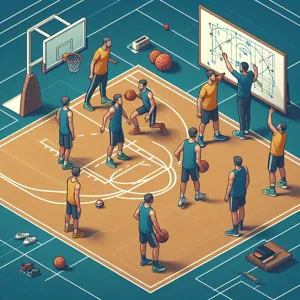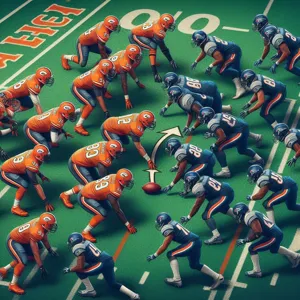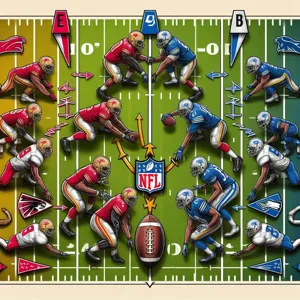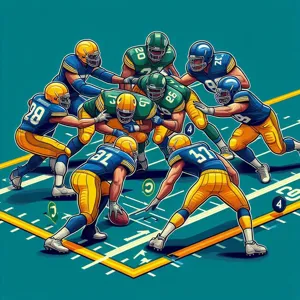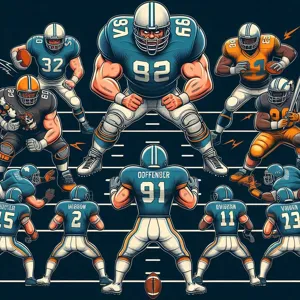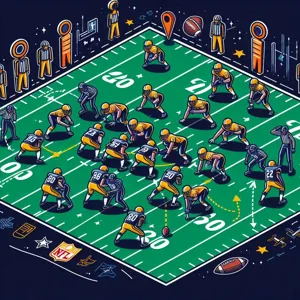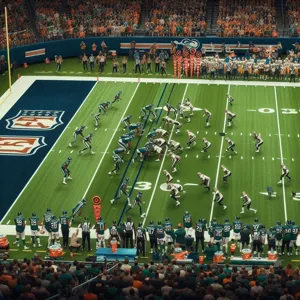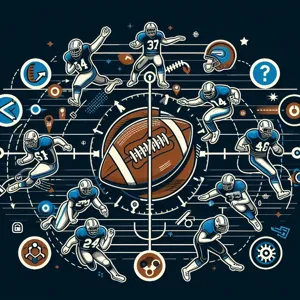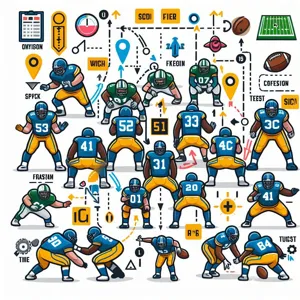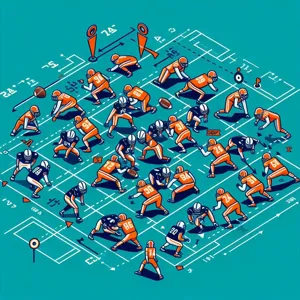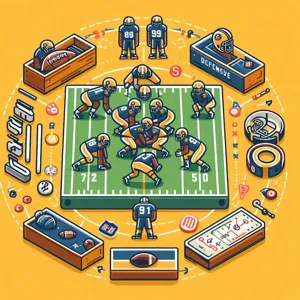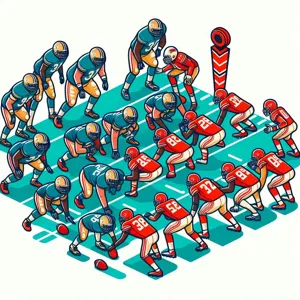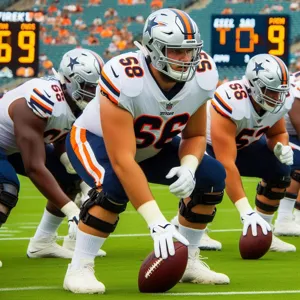Basketball is more than just a game; it’s a dynamic clash of strategy, skill, and teamwork that unfolds on the court with every dribble, pass, and shot.
Whether you’re an aspiring player looking to sharpen your skills or a passionate fan eager to understand the intricacies of the sport, diving deep into the world of basketball offenses and defenses is essential. This blog post, “Mastering the Court,” invites you to explore the art and science behind various offensive strategies like the pick-and-roll and fast break, alongside defensive formations such as man-to-man and zone defense. We’ll break down their mechanics, advantages, and situational applications, empowering you with the knowledge to analyze plays, enhance your game, or simply appreciate the strategic depth of basketball at a whole new level. Get ready to elevate your understanding of this thrilling sport and take your court mastery to new heights!
1. Introduction to Basketball Offenses and Defenses

Basketball is a dynamic sport that combines athleticism, strategy, and teamwork, with offenses and defenses serving as the foundation of successful play. Understanding the intricacies of these systems is essential for players, coaches, and fans alike. In this section, we will explore the fundamental concepts behind basketball offenses and defenses, setting the stage for a deeper analysis of various strategies employed in the game.
At its core, an offense is designed to create scoring opportunities through effective movement, spacing, and ball distribution. Teams may employ different offensive philosophies, ranging from the fast-paced tempo of a transition offense to the meticulous execution of a half-court set. Key components include pick-and-roll plays, isolation strategies, and motion offenses, each designed to exploit defensive weaknesses and capitalize on scoring chances. The synergy between players—timing, communication, and understanding of roles—is what transforms a mere collection of athletes into a cohesive unit capable of executing complex plays under pressure.
On the flip side, defense is all about disruption and containment. A strong defensive strategy can stifle an opponent’s scoring efforts, forcing them into unfavorable situations. Teams can employ man-to-man defenses, which emphasize individual matchups, or zone defenses that rely on area coverage to protect the basket. Each defensive scheme carries its own strengths and weaknesses; thus, understanding how to read the opposing offense and adjust accordingly is crucial for success. Whether it’s through stifling pressure or sagging back to protect the paint, effective defense can turn the tide of a game.
As we delve deeper into the various styles and tactics employed in basketball, we will uncover the nuances that make offenses and defenses not just vital components of the game, but also the very essence of basketball strategy. Whether you’re a budding player looking to refine your skills or a seasoned coach aiming to improve team performance, mastering these concepts will elevate your understanding and appreciation of the sport. So grab your sneakers, lace them up, and get ready to break down the barriers of basketball knowledge!
2. Overview of Basketball Fundamentals
Basketball, often regarded as a symphony of athleticism and strategy, is built on a foundation of fundamental skills that every player must master to be effective on the court. Understanding these basics is essential not only for individual performance but also for team dynamics and overall game strategy.
At the heart of basketball fundamentals are the core skills: dribbling, shooting, passing, and defense. Dribbling is more than just bouncing the ball; it involves ball control, changing speeds, and direction to evade defenders. Players must develop both hands to maintain versatility and unpredictability. Shooting, the most celebrated aspect of the game, requires precision, balance, and follow-through, whether it’s a layup or a three-pointer. Mastering shooting mechanics can drastically improve scoring efficiency, making it crucial for players at every level.
Passing, often an underappreciated skill, is essential for ball movement and creating scoring opportunities. Effective passing involves not only accuracy but also the ability to read the defense, anticipate teammates’ movements, and deliver the ball at the right moment. Then there’s defense, which is equally vital. A solid defensive strategy involves positioning, footwork, and the ability to read the opponent’s plays. Understanding how to effectively guard players and disrupt offensive strategies can change the course of a game.
In addition to these skills, players must also grasp the concepts of spacing, teamwork, and communication. Spacing on the court ensures that teammates are positioned in a way that maximizes offensive opportunities while minimizing defensive pressure. This requires a keen awareness of both the ball and the players around them. Teamwork goes beyond just passing the ball; it’s about supporting each other, making smart decisions, and playing cohesively. Lastly, communication is key in both offense and defense. Players must talk to each other, call out plays, and provide feedback to ensure everyone is on the same page.
By mastering these fundamental skills and concepts, players can elevate their game, making them valuable assets to their teams. Whether you’re a beginner looking to build a solid foundation or an experienced player aiming to refine your skills, a deep understanding of basketball fundamentals is essential for success on the court.
3. The Importance of Offensive Strategy

In the dynamic world of basketball, the importance of a well-crafted offensive strategy cannot be overstated. Offense is where artistry meets athleticism, and a team’s ability to coordinate movement, timing, and spacing can make the difference between a win and a loss. A solid offensive strategy not only maximizes scoring opportunities but also keeps the defense guessing, creating an unpredictable flow that can frustrate even the most disciplined opponents.
At its core, an effective offensive strategy is built on a foundation of teamwork and communication. Players must understand their roles within the system—whether they are primary scorers, facilitators, or defenders in transition. For instance, a pick-and-roll offense leverages the unique talents of a ball-handler and a screener, creating mismatches and open shots. This strategy requires precision timing and an instinctive understanding between players, as any miscommunication can lead to turnovers and wasted possessions.
Moreover, a well-structured offensive strategy considers the strengths and weaknesses of the players on the court. Coaches often tailor their approach based on the personnel available, emphasizing fast breaks for teams with speed and agility, or relying on post plays if they have a dominant big man. This adaptability is crucial; as the game evolves, so too must the strategies employed to stay ahead of the competition.
Another key component of offensive strategy is spacing. Proper spacing allows players to move freely without overcrowding the court, making it easier to penetrate defenses and create open shots. Teams that excel at spacing force defenses to stretch and adjust, often leading to breakdowns and mismatches that can be exploited. Modern offenses often incorporate three-point shooting to further enhance spacing, as a threatening perimeter presence opens up driving lanes for slashers and cutters.
Ultimately, mastering offensive strategy is about more than just scoring; it’s about creating a rhythm and flow that embodies the team’s identity. A cohesive offensive unit can dictate the pace of the game, control tempo, and maintain pressure on the opposing defense, all while fostering an environment where players feel empowered to make plays. As teams delve into the nuances of offensive strategy, they unlock the potential for creativity and innovation on the court, leading to a more dynamic and exciting style of play that captivates both players and fans alike.
4. Common Offensive Sets: Overview
When it comes to basketball, understanding common offensive sets is crucial for any player or coach looking to maximize scoring opportunities. Each offensive set is designed to create space, facilitate ball movement, and exploit defensive weaknesses, allowing teams to execute plays effectively. Here, we’ll explore a few popular offensive sets that have stood the test of time and are widely used at various levels of the game.
**1. The Motion Offense**
The motion offense is a fluid and dynamic approach that emphasizes teamwork and player movement. In this set, players are encouraged to read the defense and make decisions based on the flow of the game. The key principles involve constant motion, setting screens, and creating passing lanes. By keeping the ball moving and players cutting to open spaces, this offensive set can create high-percentage shot opportunities. The motion offense is particularly effective in maintaining spacing and utilizing the strengths of each player on the court.
**2. The Pick and Roll**
The pick and roll is a staple of basketball strategy and is often considered one of the most effective offensive plays. This set involves two players: one sets a screen (the pick) for a teammate handling the ball (the roller) and then rolls toward the basket to receive a pass. This dynamic interaction puts significant pressure on the defense, forcing them to make quick decisions about whether to switch or help. The versatility of the pick and roll allows it to be adapted to various player skill sets, making it a favorite among both guards and big men.
**3. The Triangle Offense**
Popularized by legendary coach Phil Jackson, the triangle offense is built around creating spacing and maximizing player movement. This system centers on a triangle formation formed by three offensive players on one side of the court, while the other two players spread out. The triangle allows for numerous options, including passing, cutting, and driving to the basket. This offense relies heavily on basketball IQ, as players must read the defense and make quick decisions. Its complexity can be challenging to master, but when executed correctly, it can lead to beautiful teamwork and high-scoring games.
**4. The Isolation Offense**
Isolation sets are often employed when a team wants to take advantage of a particular player’s skill set, especially if they have a significant mismatch against a defender. In this scenario, other players move away from the action, allowing the designated player to create their own shot through dribbling, driving, or post moves. While isolation can lead to spectacular individual performances, it requires a careful balance to ensure that the rest of the team remains engaged and ready to contribute.
Understanding these common offensive sets is essential for any player or coach looking to improve their game. By mastering these tactics, teams can enhance their offensive efficiency and create more scoring opportunities on the court, ultimately leading to better performance and success in games. As we dive deeper into the intricacies of basketball, these offensive strategies form the foundation for more advanced plays and adaptations that can be tailored to fit any team’s unique strengths.
5. The Pick and Roll: Execution and Variations
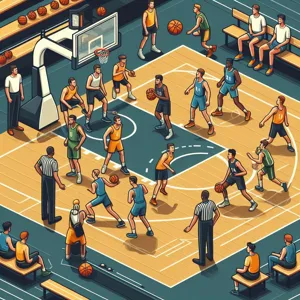
The pick and roll is one of the most fundamental and effective offensive plays in basketball, seamlessly combining strategy, skill, and teamwork. At its core, the play involves two players: one sets a screen (the “pick”) for a teammate handling the ball and then moves toward the basket (the “roll”) to receive a pass. This simple yet powerful maneuver can create multiple scoring opportunities, making it a staple in the playbooks of teams at every level of the game.
**Execution of the Pick and Roll**
To execute the pick and roll effectively, communication and timing are crucial. The ball handler must be aware of the defender’s positioning, allowing them to make quick decisions as the screen is set. Meanwhile, the screener must hold their position momentarily to ensure the defender is successfully blocked before rolling towards the basket. As the play unfolds, the ball handler can either drive to the basket, pull up for a jump shot, or pass to the rolling teammate, depending on how the defense reacts. The effectiveness of this play lies in its ability to create mismatches, forcing defenders to make split-second decisions that can lead to open looks or breakdowns in their coverage.
**Variations of the Pick and Roll**
Beyond its basic execution, the pick and roll offers a plethora of variations that teams can utilize to keep their opponents guessing. One popular variation is the “pick and pop,” where the screener, instead of rolling to the basket, steps back to the perimeter for a jump shot after setting the screen. This variation is particularly effective when the screener is a strong outside shooter, stretching the defense and creating additional space for the ball handler.
Another variation is the “double drag,” which involves two consecutive screens set by two players in succession. This approach can confuse defenders and create multiple options for the ball handler, who can choose to exploit the resulting mismatches or driving lanes. Additionally, teams might implement a “high pick and roll,” where the screen is set further away from the basket, allowing for a more expansive offensive setup and the potential for a deeper shot or a clear lane to drive.
**Defensive Strategies Against the Pick and Roll**
Defensively, teams must be prepared to counter the pick and roll effectively. Common strategies include switching defenders, hedging, or trapping the ball handler. Each approach comes with its own set of advantages and challenges, and the effectiveness of these strategies often hinges on the personnel and specific dynamics of the game. Switching, for instance, can help prevent mismatches but may leave defenders vulnerable if the switch isn’t executed cleanly. Hedging can temporarily disrupt the ball handler’s momentum but requires the screener’s defender to fully commit to the hedge before recovering.
In conclusion, mastering the pick and roll is essential for any offensive scheme in basketball. Its simplicity belies its effectiveness, and with the right execution and variations, it can become a team’s most potent weapon. As players refine their skills and understanding of this play, they unlock new levels of offensive creativity, keeping defenders on their toes while ensuring the team remains a formidable force on the court.
6. Motion Offense: Principles and Benefits
The motion offense is a dynamic and fluid style of play that emphasizes teamwork, movement, and versatility on the basketball court. At its core, the motion offense is built around the principle of constant motion, where players are encouraged to read the defense and react accordingly. This system thrives on the idea that basketball is not just about individual talent but rather about how well players work together to create opportunities.
One of the foundational principles of the motion offense is spacing. Players must be strategically positioned to allow for both driving lanes and passing options. This requires a keen understanding of positioning and awareness of teammates’ movements. The offense typically employs a variety of cuts—such as backdoor cuts, V-cuts, and give-and-go actions—that keep defenders on their toes. This unpredictability forces defenses to communicate and adapt quickly, often leading to breakdowns that can be exploited for easy baskets.
Another key element is the concept of “reading the defense.” Players are encouraged to make decisions based on defenders’ reactions rather than strictly adhering to a set play. If a player receives the ball and sees a defender overextending, they might drive to the hoop or kick it out to an open teammate on the perimeter. This adaptability fosters a sense of trust and synergy among teammates, as they learn to anticipate each other’s movements and instincts.
The benefits of adopting a motion offense are numerous. Firstly, it promotes ball movement, which can lead to higher-quality shot opportunities. Teams that effectively implement a motion offense often enjoy higher shooting percentages due to the open looks generated by quick passes and player movement. Additionally, this style of play can help mitigate the impact of a dominant defensive player, as the emphasis on teamwork can often neutralize individual defensive prowess.
Moreover, the motion offense can be tailored to suit the strengths of the players on the team. Coaches can emphasize different aspects of the offense, such as perimeter shooting or interior play, depending on their roster. This versatility makes the motion offense an excellent choice for teams with varying skill sets and player abilities.
In summary, the motion offense is not just a strategy but a philosophy of basketball that champions teamwork, adaptability, and intelligent decision-making. By mastering the principles of spacing, movement, and reading the defense, teams can unlock a potent offensive arsenal that keeps opponents guessing and maximizes their scoring potential. Embracing this style of play can lead to not only improved performance on the court but also a deeper understanding of the game itself.
7. Understanding Zone Defense: Types and Strategies

Zone defense is a vital component of basketball strategy that can significantly alter the dynamics of a game. Unlike man-to-man defense, where players are assigned specific opponents to guard, zone defense focuses on protecting specific areas of the court. This approach can confound opposing offenses and create opportunities for turnovers and fast breaks. Understanding the different types of zone defenses, along with their strategies, is essential for any player or coach looking to master the game.
### Types of Zone Defense:
1. **2-3 Zone Defense**: This is one of the most common zone defenses, consisting of two players positioned at the top of the key and three players near the basket. This formation effectively protects the paint while still applying pressure on outside shooters. The key to mastering the 2-3 zone is communication between players, ensuring that everyone knows when to switch assignments and close out on shooters.
2. **3-2 Zone Defense**: The 3-2 zone places three players on the perimeter and two in the post. This configuration is particularly effective against teams that rely heavily on three-point shooting, as it allows for a stronger presence on the outside while still providing some protection against drives to the basket. The challenge here lies in effectively rotating players to cover both the interior and the perimeter.
3. **1-3-1 Zone Defense**: This more aggressive zone defense features one player at the top, three players spread across the middle, and one player protecting the rim. The 1-3-1 can create turnovers by forcing opponents into difficult shots, but it requires quick reflexes and strong communication to prevent easy baskets from the baseline.
4. **Box-and-One Defense**: This hybrid defense combines man-to-man and zone principles. Four players form a box around the key, while one player is tasked with guarding a specific offensive player man-to-man. This strategy is particularly useful against teams with a standout scorer, as it allows the defense to focus on shutting down that player while still maintaining zone principles.
### Strategies for Effective Zone Defense:
– **Ball Movement and Awareness**: Players must be adept at maintaining their positions while anticipating ball movement. Quick, decisive rotations are crucial to closing out on shooters and preventing open looks.
– **Communication**: Effective zone defense relies heavily on verbal and non-verbal communication. Players must continuously call out screens, switches, and movements to ensure everyone is on the same page.
– **Anticipate Passes**: Players should work on reading the offense, anticipating passes and positioning themselves to intercept or disrupt the ball movement. This proactive approach can lead to fast-break opportunities and easy baskets.
– **Rebounding**: A common misconception is that zone defenses are less effective at rebounding. In reality, players must be disciplined in locating their assignments when the shot goes up, boxing out to secure the ball, and transitioning quickly to offense.
By mastering these types and strategies of zone defense, teams can create a formidable presence on the court, successfully stifling their opponents’ offensive flow and paving the way for their own scoring opportunities. Understanding the intricacies of zone defense not only enhances a team’s defensive capabilities but also fosters a deeper appreciation for the tactical nature of basketball.
8. Man-to-Man Defense: Key Concepts and Techniques
Man-to-man defense is one of the most fundamental and effective defensive strategies in basketball, requiring players to take personal responsibility for their assigned opponents. This defensive approach emphasizes individual skill, teamwork, and adaptability, making it essential for any player looking to master the game.
### Key Concepts
1. **Assignment:** In a man-to-man defense, each defender is responsible for a specific offensive player. This means that defenders must stay locked in on their assignments, understanding their opponent’s tendencies, strengths, and weaknesses. Communication among teammates is critical, as players must alert each other to screens, cuts, and any changes in assignments that may occur during fast-paced gameplay.
2. **Positioning:** Effective man-to-man defense begins with proper positioning. Defenders should keep a low stance, balanced on the balls of their feet, ready to move in any direction. Maintaining an appropriate distance—close enough to contest shots but far enough to prevent easy drives—is crucial. This balance allows defenders to react quickly to offensive movements while minimizing the risk of fouls.
3. **Help Defense:** While each player has an assigned opponent, the team must work together to provide help defense when necessary. If a defender gets beaten off the dribble or a screen is set, teammates should be ready to slide over and assist. This requires excellent communication and awareness, as defenders must quickly identify when to provide help and when to return to their original assignments.
### Techniques
1. **Closeouts:** Closing out on an offensive player is a critical skill in man-to-man defense. When an opponent receives the ball, defenders must sprint towards them, raising their hands to contest shots while simultaneously maintaining a low center of gravity to stay balanced. The goal is to put pressure on the shooter without overcommitting, allowing them to drive past for an easy basket.
2. **Boxing Out:** In addition to guarding the ball, man-to-man defense also involves securing rebounds. After a shot goes up, defenders must box out their assigned players, establishing position to grab the rebound. This technique involves using body positioning to prevent offensive players from getting an advantage and creating second-chance opportunities.
3. **Anticipation and Reaction:** A successful man-to-man defender must possess sharp instincts. This involves not only reading the offensive player’s movements but also anticipating their next actions. By recognizing patterns—such as a tendency to drive left or shoot from a particular spot—defenders can position themselves to disrupt plays effectively.
By mastering these concepts and techniques, players can significantly enhance their man-to-man defensive skills, making them formidable on the court. Whether you are a seasoned player or just starting, focusing on these foundational elements will elevate your defensive game and contribute to your team’s overall success.
9. Transition Offense: Fast Break Strategies
In basketball, the transition offense, often referred to as the fast break, is a thrilling aspect of the game that can catch opponents off guard and create high-scoring opportunities. This strategy hinges on the principle that speed and decisiveness can outpace even the most well-organized defenses. As soon as your team secures possession of the ball—whether through a rebound, steal, or forced turnover—the clock begins ticking on the fast break.
Effective transition offense relies on quick decision-making and precise execution. Players must sprint down the court, filling lanes strategically to stretch the defense and create immediate scoring chances. The key is to maintain proper spacing, allowing for easy passing options and driving lanes. Guards typically lead the charge, pushing the ball up the court, while forwards and centers trail behind, ready to capitalize on any mismatches that may arise.
One successful strategy involves the “three lanes” concept: one player takes the middle lane, while two others flank the sides. This formation not only maximizes the width of the court, making it difficult for defenders to recover, but also enhances the likelihood of finding an open shot or an easy layup near the rim. Additionally, the trailing players should always be aware of their teammates’ positions and ready to take advantage of any defensive lapses.
Moreover, a well-executed fast break can pivot on the moment of anticipation. Players must be tuned into the rhythm of the game, ready to react the instant they secure possession. Timing is crucial—if a player hesitates, the opportunity may vanish. When done right, a transition offense can not only put points on the board but also demoralize opponents, forcing them to scramble back and disrupt their defensive flow.
Incorporating drills focused on speed, communication, and teamwork can enhance your team’s transition offense, ensuring that players understand their roles and develop a rhythm that allows for seamless execution. Mastering these fast break strategies can elevate your game, transforming your squad into a dynamic offensive powerhouse that keeps the pressure on the opposition throughout the match.
10. Defensive Rebounding: Techniques for Success
Defensive rebounding is a critical aspect of basketball that often determines the outcome of a game. While many fans focus on points scored and flashy offensive plays, the importance of securing the ball after a missed shot cannot be overstated. A strong defensive rebound not only prevents the opposing team from getting second-chance points but also provides your team with the opportunity to transition into offense. Here are some key techniques to master defensive rebounding and establish dominance on the court.
**Boxing Out:** One of the fundamental techniques of defensive rebounding is boxing out. This involves establishing position between your opponent and the basket as soon as a shot goes up. Use your body to shield the shooter while keeping your eyes on the ball. Get low, widen your stance, and use your arms to create space. The goal is to create a barrier that prevents offensive players from leaping to snag the rebound.
**Timing Your Jump:** A successful rebound often comes down to timing. As the ball approaches its apex, you need to gauge the trajectory and make your move. Jumping too early can lead to missed opportunities, while jumping too late might allow opponents to grab the board. Practice your vertical leap and develop an instinct for when to rise. Remember, it’s not just about height; it’s about positioning and anticipation.
**Use of Hands:** Be proactive with your hands when going for a rebound. Keep your hands up and ready to snatch the ball out of the air. After securing the rebound, quickly transition into a safe outlet pass to initiate the offensive play. This not only keeps the flow of the game moving but also demonstrates your awareness on the court.
**Communication:** Effective communication among teammates is essential for successful defensive rebounding. Call out who has the responsibility for boxing out and make sure everyone is aware of their assignments. A well-coordinated team can create multiple layers of defense around the basket, making it difficult for opponents to secure offensive rebounds.
**Reading the Shooter:** Finally, understanding the tendencies of the shooter can give you an edge. Is there a particular spot where they prefer to shoot? Do they consistently miss in the same direction? By analyzing shooting patterns, you can position yourself appropriately and increase your chances of grabbing the rebound.
Mastering defensive rebounding requires practice, discipline, and a keen understanding of both your teammates and opponents. By focusing on these techniques, you can enhance your defensive game and contribute significantly to your team’s overall success on the court.
11. The Role of Communication in Offense and Defense
In the fast-paced world of basketball, communication is the backbone that holds together both offensive strategies and defensive schemes. It’s not just about the physical skills or the tactics on paper; effective communication transforms a group of talented players into a cohesive unit that can outmaneuver and outsmart opponents on the court.
On offense, communication begins with the point guard, often seen as the floor general. This player must vocalize plays, signaling when to set screens, cut to the basket, or pop out for a three-pointer. But it’s not solely the responsibility of the point guard; each player must be alert and responsive. Eye contact, hand signals, and vocal cues are all critical as players move without the ball, ensuring they’re synchronized and ready to exploit defensive weaknesses. A well-timed shout can indicate a change in play, while a simple nod may signify readiness to execute a fast break. When players share a common language, they can anticipate each other’s movements, leading to more fluid and effective offensive execution.
Conversely, on the defensive end, communication is just as vital. Defenders need to call out switches, alert teammates to screens, and signal when to tighten up on an opponent or help out a fellow player. A well-coordinated defense thrives on constant chatter; phrases like “screen left” or “help!” can mean the difference between a contested shot and an easy basket for the opponent. Moreover, effective communication fosters trust among players, allowing them to take calculated risks without hesitation, knowing that their teammates are aware and ready to adapt.
In essence, communication in basketball is not just about relaying information; it’s about building chemistry and understanding among teammates. Teams that prioritize open lines of communication often find themselves better equipped to handle the ebb and flow of a game, whether they are orchestrating a precise offensive play or executing a dynamic defensive strategy. As players continually work on their communication skills, they enhance their overall performance, creating a more formidable presence on the court.
12. Analyzing Effective Plays from Professional Teams
When it comes to mastering basketball, understanding the strategies employed by professional teams can provide invaluable insights for players, coaches, and enthusiasts alike. Analyzing effective plays from top-tier teams not only showcases the intricate dynamics of the game but also highlights the creativity and adaptability required to succeed on the court.
Take, for instance, the Golden State Warriors’ renowned “Splash Brothers” offense, characterized by its emphasis on spacing and ball movement. This system thrives on creating open looks for sharpshooters Stephen Curry and Klay Thompson, often pulling defenders out of position with their ability to shoot from beyond the arc. By utilizing pick-and-rolls, off-ball screens, and quick passes, the Warriors create a dizzying rhythm that keeps defenses guessing. Observing how they exploit mismatches and leverage their shooting range can provide a blueprint for developing a high-octane offense.
Similarly, the San Antonio Spurs have long been lauded for their “beautiful game,” an offense built on unselfish ball movement and precise execution. The Spurs’ ability to read defenses and make quick decisions leads to easy baskets, often through well-timed cuts and open three-point shots. Analyzing their plays reveals the importance of teamwork and communication, demonstrating that basketball is as much about the collective effort as it is about individual talent.
On the defensive end, teams like the Milwaukee Bucks showcase the effectiveness of a strong, versatile defense anchored by a dominant rim protector like Giannis Antetokounmpo. Their strategy often focuses on funneling attackers toward the paint, creating a wall of defense that is tough to penetrate. Studying their rotations and how they switch on screens can illuminate the importance of adaptability and awareness in defensive schemes.
Ultimately, analyzing these effective plays from professional teams offers a treasure trove of knowledge for aspiring basketball players and coaches. By dissecting the strategies, techniques, and philosophies of the game’s best, one can gain a deeper appreciation for the nuances of offense and defense, enhancing their own understanding and execution on the court. Whether it’s picking up on the subtleties of spacing or recognizing the importance of defensive rotations, there’s always something to learn from the pros.
13. Adapting Strategies Against Different Opponents
In the dynamic world of basketball, adaptability is key to outsmarting your opponents. Every team brings a unique style of play, influenced by their strengths, weaknesses, and overall philosophy. Understanding how to adjust your offensive and defensive strategies in response to these variations can be the difference between victory and defeat.
When facing an opponent known for their aggressive defense, such as a full-court press, your offense must prioritize ball movement and spacing. Quick passes and off-ball screens become essential tools for breaking through the pressure. Encourage players to create passing lanes and utilize the dribble to draw defenders away, opening up opportunities for easy baskets or open three-point shots. Keep your players engaged in constant motion to disrupt the defensive flow and keep the pressure on.
Conversely, when up against a team with a strong offensive lineup, a shift in defensive strategy might be necessary. Adopting a more aggressive man-to-man defense could be crucial in disrupting their rhythm. This could involve switching on screens, applying ball denial, and ensuring that your weakest defender is matched against their least impactful offensive player. Additionally, implementing a zone defense can be highly effective against teams that rely heavily on perimeter shooting, as it can clog the passing lanes and force contested shots.
Moreover, it’s vital to analyze your opponents’ tendencies through game film. Look for patterns in their play—do they favor certain players in clutch moments? Are they more effective at home or on the road? Use this data to inform your game plan, making real-time adjustments as the game unfolds. Being able to read the flow of the game and adapt your strategies accordingly will keep your team one step ahead.
Ultimately, the ability to pivot your game plan based on the opponent not only showcases your team’s versatility but also instills confidence among players. They will understand that they are prepared for any challenge that comes their way, fostering a resilient mentality that can carry them through high-pressure situations. Mastering this adaptability is crucial for any team aspiring to dominate the court and achieve their championship goals.
14. Drills to Improve Offensive and Defensive Skills
When it comes to mastering the court, consistent practice through targeted drills is essential for both offensive and defensive skills. These drills not only enhance individual performance but also foster teamwork and strategy execution during games.
**Offensive Drills**
1. **Ball Movement Drill**: This drill focuses on quick, accurate passes and movement without the ball. Start with three players forming a triangle, passing the ball while continuously moving to create passing lanes. This drill emphasizes the importance of spacing and communication, simulating real-game scenarios where quick decision-making can lead to open shots.
2. **Pick and Roll Practice**: The pick and roll is a fundamental offensive tactic that, when executed correctly, can be devastating. Set up pairs of players to practice setting and using screens. One player sets a solid screen while the ball handler uses it to drive toward the basket or pass to a rolling teammate. This drill promotes timing, spatial awareness, and adaptability, essential for exploiting defensive weaknesses.
3. **Shooting Under Pressure**: To simulate game conditions, set up shooting drills that involve defenders closing out. Players take shots from different spots on the court while being pressured by a defender. This not only hones shooting accuracy but also builds confidence to perform under pressure.
**Defensive Drills**
1. **Closeout Drill**: Effective defense starts with a strong closeout. In this drill, defenders practice sprinting toward the shooter, breaking down into a balanced stance, and contesting the shot without fouling. Emphasizing footwork and hand placement, this drill helps players learn how to effectively challenge shots while remaining disciplined.
2. **1-on-1 Defense**: A classic drill to sharpen individual defensive skills. Players take turns being on offense and defense, focusing on maintaining a low stance, sliding their feet, and staying in front of the ball handler. This drill reinforces the fundamental principles of defense, such as positioning and anticipation.
3. **Shell Drill**: This team-oriented drill enhances defensive communication and teamwork. Set up four offensive players around the perimeter and four defenders in a shell formation. The offense moves the ball, and the defenders work together to slide, rotate, and contest shots. This drill builds chemistry among defenders and emphasizes the importance of help defense and rotations.
Incorporating these drills into your practice regimen will undoubtedly elevate your team’s performance on both ends of the court. Remember, the key to mastering basketball is not just skill but a deep understanding of the game’s strategies and the ability to adapt in real-time. So lace up those sneakers and get to work—every drill is a step towards becoming a more formidable player!
15. Conclusion: Balancing Offense and Defense for Success
In the high-stakes world of basketball, where every dribble, pass, and shot counts, the balance between offense and defense is crucial for achieving success on the court. As we wrap up our deep dive into the intricacies of basketball strategies, it’s clear that mastering this balance is not merely a tactical choice but a fundamental pillar of winning games.
A well-executed offense is essential for scoring points, energizing the team, and captivating the crowd. However, without a solid defensive strategy to complement those offensive efforts, a team may find itself vulnerable, allowing opponents to exploit gaps and capitalize on mistakes. The most successful teams possess a dynamic synergy between offensive creativity and defensive tenacity. This duality allows players to read the game effectively, transitioning seamlessly from defense to offense and vice versa.
Consider, for example, the fluidity of a fast break following a defensive rebound. A team that can swiftly shift gears, turning defensive stops into scoring opportunities, not only puts points on the board but also demoralizes their opponents. Coaches who emphasize both offensive skills—like ball movement and spacing—and defensive principles—such as communication and pressure—instill a sense of confidence in their players. This holistic approach cultivates a culture of resilience, where athletes are prepared to adapt to the ebb and flow of the game.
In conclusion, the path to basketball mastery lies in understanding that offense and defense are not opposing forces but rather two sides of the same coin. Balancing these elements requires constant practice, strategic planning, and a commitment to teamwork. By fostering this balance, teams can elevate their performance, ensuring they not only compete but thrive on the court. As the greats of the game have shown us, it’s this delicate interplay between scoring and stopping that ultimately leads to victory.
As we conclude our deep dive into basketball offenses and defenses, it’s clear that mastering the court requires a blend of strategy, teamwork, and adaptability. Whether you’re an aspiring player, a seasoned coach, or a passionate fan, understanding these intricate systems can elevate your appreciation for the game and enhance your own skills on the court. The insights shared in this post provide a comprehensive foundation for developing effective plays and countering your opponent’s tactics. Remember, the best teams are those that can seamlessly adjust their offensive and defensive strategies in real time. So, take these concepts, practice diligently, and watch as you transform not only your game but also your understanding of basketball as a whole. Now, get out there and start mastering your court!



